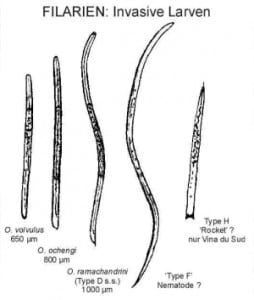The Molecular Biology Laboratory:
In 1997, the first thermocycler was bought and brought to Cameroon by Ralph Seidenfaden. Together with Daniel Achukwi from IRAD, we set up the PCR for detecting filarial-larvae in Simulium vectors with the aim of distinguishing the three main Onchocerca species, namely O. volvulus, O. ochengi and O. ramachandrini. Their L3 larvae are morphologically quiet similar, but can be distinguished during routine dissections by their length, shape of the tail and the presence of a small tip at the posterior end.
This morphological classification needs to be confirmed by molecular biology techniques. In particular in an endemic situation, where ‘true’ O. volvulus L3 became very rare as a result of over 20 years of Mectizan-masstreatments, like at our fly-catching site in the Vina du Nord valley at Soramboum (see results).

river Vina du Nord near Touboro in 1986
Typical oncho-exposure site at the river Vina du Nord near Touboro (close to the border to Chad).
People are bitten by Simulium flies, which might carry filarial larvae taken up by a previous bloodmeal on am Onchocerca-infected person or animal (=> Onchocerca-transmission cycles).
Biting rates may exceed 100 bites per person and day and up to 5 % of these flies may carry infective Onchocerca larvae (L3).
To distinguish the human from the animal Onchocerca-larvae, molecular-genetic tools are now introduced. This is the more important, as the regular treatment of the human population by Mectizan (since 1987, now by APOC) has virtually eliminated most of the human-pathogenic O. volvulus larvae. The few remaining larvae of this species still present in man-biting flies must be unequivocally distinguished from those of O. ochengi (cattle) and O. ramachandrini (warthog) and other non-human filarial worms.
In our DFG-project, Albert Eisenbarth has just finished building up the bio-molecular lab. He uses PCR to amplify filarial genes from all kind of Simulium and other blood-sucking flies, coming to bite on man and cattle. The identity of single filarial larvae (and microfilariae, adults etc.) is then confirmed by sequencing of the PCR-products in Tübingen. The same approach is used to identify Ceratopogonid and Culicid vectors, that are likely to be the yet unknown vectors for O. armillata, O. gutturosa and Setaria labiatopapillosa in this region.

Preparing for PCR in the laboratory in Ngaoundéré
Read more about a workshop on molecular techniques held by Dr. Albert Eisenbarth:



Leave a Reply
Want to join the discussion?Feel free to contribute!